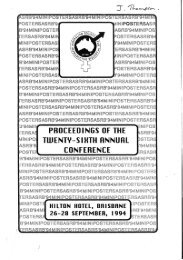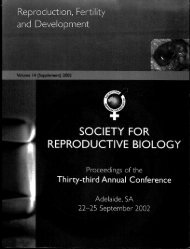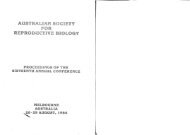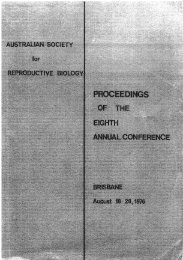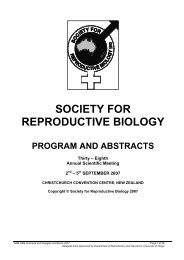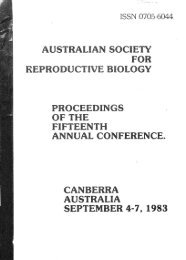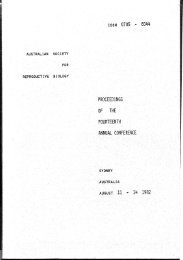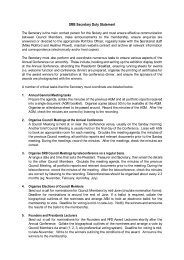ruoounu. nnSlunCIS&UINI-rOSIlnS - the Society for Reproductive ...
ruoounu. nnSlunCIS&UINI-rOSIlnS - the Society for Reproductive ...
ruoounu. nnSlunCIS&UINI-rOSIlnS - the Society for Reproductive ...
You also want an ePaper? Increase the reach of your titles
YUMPU automatically turns print PDFs into web optimized ePapers that Google loves.
SEASONALITY AND NEUROENDOCRINOLOGYSEASONALITY AND NEUROENDOCRINOLOGYADVANCING A SHORT NIGHT SIGNAL DOES NOT NECESSARILY STOP OVARIANACTIVITY EARLIER IN THE EWE.Michael Guerin, Jim Deed and Colin Mat<strong>the</strong>wsDepartment ofObstetrics and Gynaecology, The University ofAdelaide, Adelaide South Australia 5000AIMSWe have proposed that <strong>the</strong> signal <strong>for</strong> <strong>the</strong> cessation ofovarian activity in seasonal breeding ewes is light coincident with an.afternoon-located sensitive phase of<strong>the</strong> circadian pacemaker. In earlier studies when similar 8-week treatments. o~ short mghts(which advance <strong>the</strong> afternoon portion of<strong>the</strong> pacemaker into <strong>the</strong> light) have been utilised.we have rep~rted CO~ICtingresultson <strong>the</strong> timing ofoestrus offset (1 )(2). In this study we have provided 8 weeks ofshort mghts at tw~ different ~es, ~n~commencing four weeks earlier than <strong>the</strong> o<strong>the</strong>r, to examine <strong>for</strong> any effect on <strong>the</strong> timing of<strong>the</strong> cessanon ofovanan actiVIty.METHODSThree groups of6 mature Romney Marsh ewes were established at <strong>the</strong> Waite Campus of<strong>the</strong> ~niversi~ ofAdelaide in early1998. Group 1 remained outside under natural conditions throughout. Group 2 was br~ught mto envrronment c?ntrolledrooms and subjected to eight weeks ofshort night photoperiod (10D:14L) from 21 Apni. Group 3 was brou~ht m andsubjected to eight weeks ofshort night photoperiod (10D:14L) from 21 May. At <strong>the</strong> end ofeach 8-week penod Groups 2 & 3were subjected to long night photoperiods (14D:lOL) until 21 December 1998 when both groups were paddocked.All ewes were blood sampled twice a week <strong>for</strong> progesterone determinations to monitor ovarian activity throughout. ?n twooccasions during short night treatments and three during long night treatments all ewes were blood sampled over 2 mghts. Thefirst night under treatment conditions to monitor endogenous melatonin elevation and <strong>the</strong> second night under acutely extendeddarkness where melatonin acts as a marker <strong>for</strong> pacemaker activity.RESULTSThere were no differences between <strong>the</strong> groups in <strong>the</strong> timing of<strong>the</strong> mid-year cessation ofovarian activity (see Figure 1). Thetiming of<strong>the</strong> onsets and offsets ofinduced ovarian activity <strong>for</strong> Groups 2 &3 were not different. The measure~ents ofendogenous melatonin demonstrated that all animals in Groups 2 & 3 correctly perceived <strong>the</strong> short and long mght treatments.The marker ofpacemaker activity indicated that <strong>the</strong> short night treatments advanced <strong>the</strong> afternoon portion of<strong>the</strong> pacemakerinto <strong>the</strong> light.OutsideControlGroupNATURAL PHOTOPERIOD: 1 I•AIMSORAL MELATONIN ADMINISTERED TO CYCLING MARES IN AUTUMN DOES NOTADVANCE ANOESTRUS.METHODSM Guerin, J Deed, R Woodward*, D Washington* and C Mat<strong>the</strong>wsDepartment ofObstetrics and Gynaecology, *Department ofAnimal ScienceThe University ofAdelaide, Adelaide South Australia 5000We have proposed that <strong>the</strong> timing <strong>for</strong> seasonal breeding is dependent on <strong>the</strong> correct sequence oflight anddark/melatonin signals to <strong>the</strong> endogenous circadian pacemaker. Studies in <strong>the</strong> ewe indicate <strong>the</strong>re is an aftemoonlocatedsensitive phase of<strong>the</strong> pacemaker that sets up <strong>the</strong> reproductive system when light is coincident withitin <strong>the</strong>short days ofspring/summer. The same sensitive phase <strong>the</strong>n directly signals <strong>the</strong> onset ofoestrus when it iscoincident with darkness/melatonin in <strong>the</strong> leng<strong>the</strong>ning days ofautumn (1). Exogenous melatonin in <strong>the</strong> afternoon,not <strong>the</strong> morning, will mimic long nights to maintain existing ovarian activity (2) and will initiate new ovarianactivity in ewes already primed with short nights (3).Exogenous melatonin, in <strong>the</strong> afternoon not <strong>the</strong> morning, has been shown to inhibit <strong>the</strong> effect ofadditional artificiallight that normally advances <strong>the</strong> time ofseasonal breeding in <strong>the</strong> horse mare (4). From studies ofmelatonin as amarker <strong>for</strong> <strong>the</strong> endogenous circadian pacemaker we have proposed that <strong>the</strong> mare may use a similar basicmechanism to time seasonal breeding as <strong>the</strong> ewe (5). Since <strong>the</strong> mare is considered to be a "long day" breeder, <strong>the</strong>administration ofexogenous melatonin should be inhibitory to ovarian activity. In this study we administered oralmelatonin, in <strong>the</strong> afternoon or morning, to mares during <strong>the</strong> autumn to see ifei<strong>the</strong>r treatment could mimic darknessand advance anoestrus.In late March 1999 three groups offive Standardbred mares were established at <strong>the</strong> Roseworthy Campus ofTheUniversity ofAdelaide (latitude 35°S). All mares were confirmed in oestrus, and ovulating, by ultrasound scanningand blood progesterones. Commencing on 30 March two groups were orally administered a daily 12 mgm dose ofmelatonin, in a 1 ml solution, given at ei<strong>the</strong>r 30 mins prior to sunrise or 4 hrs prior to sunset. The dose given hadpreviously been shown to elevate plasma melatonin in <strong>the</strong> horse to normal nighttime levels, or greater, <strong>for</strong> at least 5hours. All mares were blood sampled twice weekly throughout and progesterone determinations were per<strong>for</strong>med tomonitor ovarian activity. Anoestrus was taken as <strong>the</strong> date of<strong>the</strong> last confirmed ovulation <strong>for</strong> <strong>the</strong> season.; SHORT NIGHTS ~LONG NIGHTSNATURALRESULTSGrouplGroup 3: SHORT NIGHTS:: I I :LONG NIGHTSNATURAL____L~~ MA~_l!~ i JULY i AUG 1 SEPT I ocr I NOV I DEC I JAN !Figure 1. The ovarian activity<strong>for</strong> <strong>the</strong> three groups during <strong>the</strong> course of<strong>the</strong> experiment. The shaded blocksillustrate <strong>the</strong> periods ofextended cyclic pattern as determined by twice-weekly plasma progesterone.CONCLUSIONSA short night signal (light on <strong>the</strong> afternoon portion of<strong>the</strong> pacemaker) four weeks earlier than natural oestrus cessation time didnot alter <strong>the</strong> timing, however it still provided <strong>the</strong> priming signal <strong>for</strong> induced ovarian activity in subsequent long nights. Thecircadian mechanism that times <strong>the</strong> offset ofovarian activity requires fur<strong>the</strong>r investigation.Guerin MV & Mat<strong>the</strong>ws CD. (1998) 1. BioI. Rhytluns 13,60-69Guerin MV, Deed JR & Mat<strong>the</strong>ws CD. (1998) Proc. Aust. Soc. Reprod. BioI. 29,36(Acknowledgment. This research was supported by a Large ARC Grant to Mat<strong>the</strong>ws and Guerin)There were no differences in <strong>the</strong> timing ofanoestrus between <strong>the</strong> 3 groups. The Control Group ceased ovarianactivity on 18 May (2:19.5 days), <strong>the</strong> Morning Melatonin Group on 24 May (±19.6 days) and <strong>the</strong> AfternoonMelatonin Group on 15 June (± 38.4 days).CONCLUSIONSAlthough oral melatonin in <strong>the</strong> afternoon has been shown to block light advancing <strong>the</strong> onset ofoestrus (4), in thisstudy it has failed to act as darkness to advance anoestrus. It is possible that <strong>the</strong> signal to cease ovarian activity wasperceived be<strong>for</strong>e treatments began and <strong>the</strong> treatments were insufficient to alter <strong>the</strong> outcome. Alternatively, with <strong>the</strong>mare's and <strong>the</strong> ewe's natural ovarian responses to increasing darkness different (<strong>the</strong> mare is normally anoestrousover winter and <strong>the</strong> ewe oestrous) it may be that melatonin has a different role in <strong>the</strong> timing events ofseasonaloestrus between <strong>the</strong> two species. .REFERENCES(1) Mat<strong>the</strong>ws CD, Guerin MV and Napier AJ (1995) 1. BioI. Rhythms 10,308-318(2) Guerin MV, Deed JR & Mat<strong>the</strong>ws CD. (1998) Proc. Aust. Soc. Reprod. BioI. 29, 36(3) Guerin MV, Deed JR & Mat<strong>the</strong>ws CD. (2000) Proc. Aust. Soc. Reprod. BioI. 31,(4) Palmer E and Guillaume D (1992) Anim. Reprod. Sci. 28, 21-30(5) Guerin MV, Deed JR, Kennaway DJ and Mat<strong>the</strong>ws CD (1995) 1. Pineal Res. 19,7-1526 27



